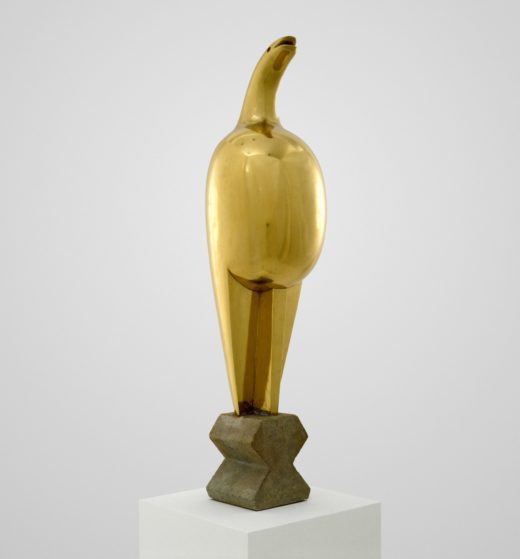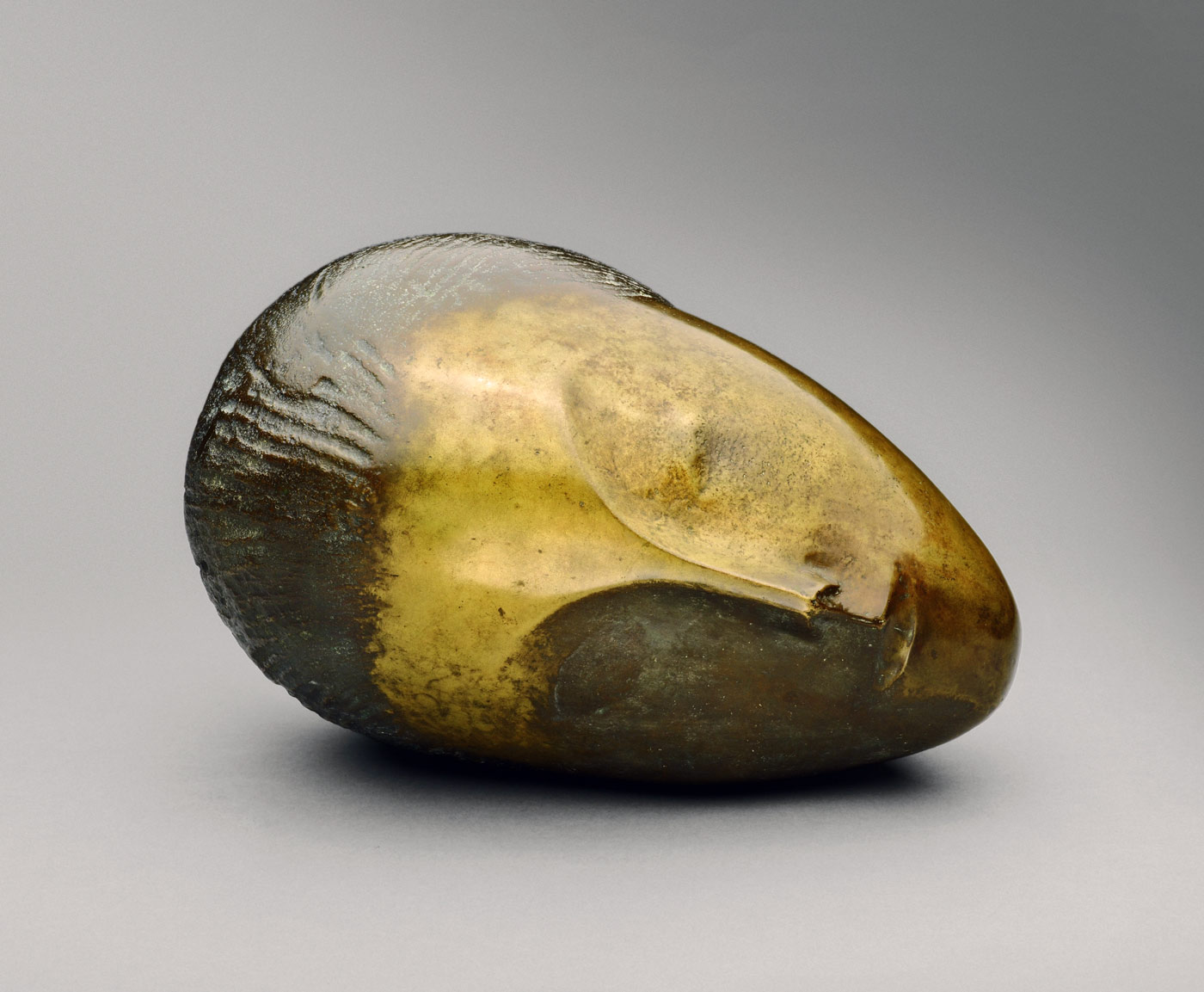MĂIASTRA: A HISTORY OF ROMANIAN SCULPTURE IN TWENTY-FOUR PARTS
Igor Gyalakuthy
 Constantin Brâncuşi, Măiastra, 1912
Constantin Brâncuşi, Măiastra, 1912
How do we present the value of Brancusi’s sculptures and the lessons of his life to this new generation without bringing along with them the rust of past analyses and dubious mythologizing? His now famous quotation upon quitting the studio of Rodin, “Nothing grows in the shade of great trees,” applies as aptly to Brancusi himself. The shadow cast by his grand, mysterious aura and the opaque sublimity of his work has left us all,
Romanians especially, stumbling around in the dark.
So instead we will work as Brancusi worked; by stripping away all of the non-essential material until what is left is the essence of the subject matter itself. This we will achieve by confronting head-on each of the problems that arise when investigating the legacy of Romania’s greatest sculptor.
THE PROBLEM OF THE WORK
Our understanding of the art of Brancusi up to the present has been based on impressionist, biographically oriented criticism on the one hand, and a fragmentary knowledge of the sculpture on the other; it has been prey to metaphysical interpretation from without and to all manner of doubt and imprecision within.¹
Mr. Geist’s disclaimer should accompany any and all writings on Brancusi, in my humble opinion. Geist believed, bravely, that the only way to gain an understanding of the significance of Brancusi was through thorough analysis of the sculptures themselves. Curiously, since his efforts, the common formal approach to Brancusi’s work seems to be an agreement that his work is difficult to approach formally. Rosalyn Krauss reminds us of this in her writings: “Given the unified quality of the single shapes, whether ovoid or finlike or voluted, there is no way to read them formally, no way to decode the set of their internal relationships, for to put it simply, no relationships
exist.”²
Accepting for a moment the dubious premise that an artist’s intention can be divined through a critical look at the evolution of his works over time, Brancusi’s intent has hinged on locating the “missing link” between his representational and abstract periods. In this search, scholars have traditionally focused their efforts on one of two of his sculptural pathways: the bird sculptures, or the ovoid-shaped heads of his muses. The debate, it seems, comes down to a question of the chicken or the egg.
Let’s begin with the chicken. From the earliest Pasearea Măiastra (1910), to the increasingly taller Bird, Yellow Bird and Golden Bird (1915-1921), and finally to the iconic Bird in Space, which, by the early 1940’s, was more than three times as tall and a third more narrow than the original, Brancusi’s trajectory is clear. Despite their
smooth forms and stylized features, the original Măiastra birds are representational, with identifiable legs, torsos and heads, puffed-up breasts, eyes and beaks. Over time, though, these representational features were absorbed into the material, and the avian shape was replaced with a carefully realized, painstakingly polished hunk of marble or bronze. What is left over is an idea, one that changed the history of sculpture forever. Said about his similar fish series, “You think of its speed, its floating flashing body seen through water…well I’ve tried to express just that(…)I want just the flash of its spirit.”³ The United States Customs Courts were less than convinced. In 1926, Brancusi’s Bird in Space was the subject of a dispute over its resemblance to a bird and therefore its value
as an art object, during which critic Frank Crowninshield contributed the following testimony: “It has the suggestion of flight, it suggests grace, aspiration, vigour, coupled with speed in the spirit of strength, potency, beauty, just as a bird does. But just the name, the title, of this work, why really, it does not mean much.”4
It’s a seductive conclusion to draw: the material embodiment of movement. But one that is undone by the existence of Brancusi’s other sculptures, most notably his portraits. Surely his intention wasn’t to capture the speed of Eileen Lane. And it’s safe to assume he was drawn to more than just the spirit of young Margit Pogany. No, the simplification-as-motion-capture seems to be limited to Brancusi’s animal subjects, like Fish, The Seal and Flying Turtle, which are not generally speaking his most significant works, with Bird in Space as the sole exception. [Note: being, as it is, the most beautiful single object in the history of modern art.]
 Constantin Brancusi, Sleeping Muse, 1910
Constantin Brancusi, Sleeping Muse, 1910
We are left, then, with the egg. Ms. Krauss saw the evolution of Brancusi’s ovoid sculptures over time as the key to unlocking his aesthetic ethos. The progression here begins with Head of a Boy (1906) and Torment (1906), and
graduates quickly to the many iterations of The First Cry and The Newborn, and eventually on to Sleeping Muse and its kin (Beginning of the World and Prometheus, among others). These ovoids begin as representational studies of the human head as an independent object and, like the birds, become more simplified with each new variation. As the cranium finds its idealized roundness, its connections to its counterpart body become increasingly distant. [Note: inviting psychoanalysis into yet another field in which it has no business.] Eventually, all that is left is the form, with a polished surface that reflects rather than reveals, a trait that has been said about the artist himself. The simplification of complex anatomical features into slight, nearly imperceptible interventions into the material represents Brancusi’s desire to boil human figures down to the static, aesthetic essence of their characters.
But on the word essence, as Brancusi used it, is where the train runs off the rails for the formalists. This is a result of the absolute impossibility of secular, academic criticism to comprehend belief as it affects the artist. The
essence Brancusi strived for existed just outside of the terrestrial, and out of reach for traditional art discourse, as a consummation of his own unique vision of himself and his role as a creator. It’s entirely possible that Brancusi
believed himself a maker not of art objects but of natural, spiritual icons. In this light, asking scholars to unpack these works is like asking for the formalist approach to the clouds in the sky.
[Note: I never met the man himself, though I was in correspondence with his biographer Sidney Geist for many years. Speaking of the spiritual, among the thousands of Costache anecdotes he shared with me, my favorite was the sculptor’s holy war against the Orthodoxy for refusing to relocate the Church that stood along the axis of his sculptural ensemble in Targu Jiu. Apparently, one late night working on the Endless Column, B. saw a stray dog urinating on one of the Church’s two columns. On all fours and with a lifted right leg, B. christened the other.]
This means shelving ideas of chickens and eggs for a moment and instead examining the man and his beliefs, which brings us to our next problem, to be addressed in the second installment. In the meantime, here is an interesting exercise: imagine that a century of dissection, mythology and appropriation have left the works of Brancusi exhausted of all possible meaning, impenetrable relics of a time when visual art was a comprehensible field of study, and of no greater value to us than a washing machine, or an aged art historian. The dangers of believing otherwise have had their effect on Brancusi’s native Romania, one we will be addressing in the third and final installment of this trilogy.
¹Geist, Sidney, Brancusi: A Study of the Sculpture, Grossman Publishers, 1968
²Krauss, Rosalind E., Passages in Modern Sculpture, MIT Press, 1981 Pg. 86
³Adlow, Dorothy, ‘Brancusi,’ Drawing & Design, vol. II (London, 1927), pg. 37-41
4 C Brancusi v United States, Treasury Decisions, 54 no 43063
[Editor’s Correction: In Part XI of this series, Dr. Gyalakuthy wrote “In 1970, I thought it
important, if risky, to deliver an account of a man whose legacy is one long, burdensome
walk through eternity.” The year, by the professor’s own account, was 1972.]
Dr. Igor Gyalakuthy is a professor emeritus at the Universitatea Nationala de Arte in Bucharest. In 1993, he received the national medal for achievement in the field of art history. He lives in Cluj-Napoca with his Lakeland terrier Bausa.










